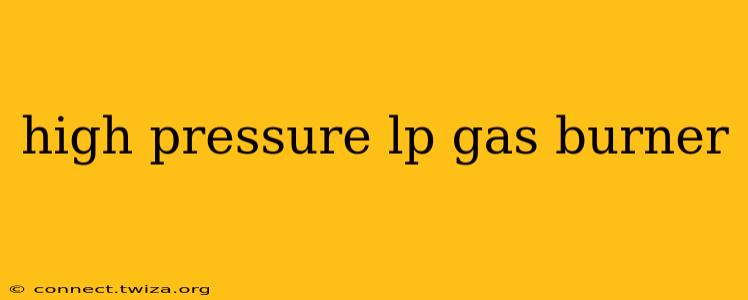High-pressure LP gas burners are essential components in various industrial and commercial applications, offering efficient and powerful heat generation. Understanding their operation, benefits, and considerations is crucial for safe and effective use. This guide delves into the intricacies of high-pressure LP gas burners, answering common questions and providing valuable insights for professionals and enthusiasts alike.
What are the advantages of using a high-pressure LP gas burner?
High-pressure LP gas burners offer several key advantages over their low-pressure counterparts. The increased pressure allows for finer control over the flame, resulting in more precise temperature regulation. This precision is critical in applications requiring specific heat input, such as industrial furnaces, kilns, and heat treating processes. Furthermore, the higher pressure leads to complete combustion, minimizing fuel waste and reducing harmful emissions. This efficiency translates to cost savings in the long run. The compact design of many high-pressure burners also contributes to space savings, making them ideal for applications with limited space. Finally, high-pressure burners often boast higher thermal efficiency, meaning more of the fuel's energy is converted into useful heat.
How does a high-pressure LP gas burner work?
High-pressure LP gas burners operate on the principle of controlled gas flow and mixing with air. LP gas, typically propane or butane, is delivered to the burner at a significantly higher pressure than low-pressure systems. This pressure is regulated by a pressure regulator, ensuring a consistent gas supply. The gas then mixes with air in a carefully designed mixing chamber, creating a homogenous mixture. This mixture is then ignited, producing a powerful and efficient flame. The design of the mixing chamber is critical, influencing the flame's shape, stability, and heat output. Different burner designs may utilize venturi effects or other techniques to optimize gas-air mixing.
What are the different types of high-pressure LP gas burners?
High-pressure LP gas burners come in a variety of designs, each tailored for specific applications. Some common types include:
- Surface Combustion Burners: These burners create a flat, even flame across a surface, suitable for applications requiring uniform heating.
- Radiant Burners: These burners radiate heat directly, ideal for heating enclosed spaces or materials.
- Flameless Burners: Designed for precise temperature control and minimal emissions, these burners achieve complete combustion without a visible flame.
- Atmospheric Burners: Simpler in design, these burners utilize ambient air for combustion, making them easier to install but potentially less efficient than others.
What safety precautions should be taken when using a high-pressure LP gas burner?
Safety is paramount when working with high-pressure LP gas burners. Always follow the manufacturer's instructions carefully. Ensure proper ventilation to prevent the buildup of harmful gases. Regularly inspect the burner and its components for leaks or damage. Never operate the burner without proper safety equipment, including eye protection and appropriate clothing. Proper training and certification are essential for safe and effective operation. Furthermore, understanding the properties of LP gas and its potential hazards is crucial for safe handling and operation.
What are the common applications of high-pressure LP gas burners?
High-pressure LP gas burners find widespread use in a multitude of industries. These include:
- Industrial Heating: Furnaces, kilns, ovens, and heat treating processes.
- Commercial Cooking: High-output cooking equipment in restaurants and food processing facilities.
- Agricultural Drying: Drying crops and agricultural products.
- Industrial Processes: Various industrial processes requiring precise temperature control.
How do I choose the right high-pressure LP gas burner for my application?
Selecting the appropriate high-pressure LP gas burner requires careful consideration of several factors:
- Heat output required: The burner's BTU rating should match the application's needs.
- Type of application: Different applications necessitate different burner designs.
- Fuel type and pressure: Ensure compatibility with the available fuel source and pressure.
- Safety features: Prioritize burners with robust safety features and controls.
- Space constraints: Consider the burner's physical dimensions and installation requirements.
This guide provides a comprehensive overview of high-pressure LP gas burners. Always consult with qualified professionals for installation, maintenance, and troubleshooting. Remember, safety should be your top priority when working with any type of gas burner.
